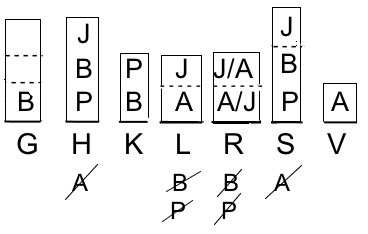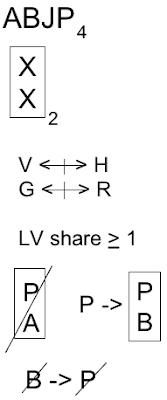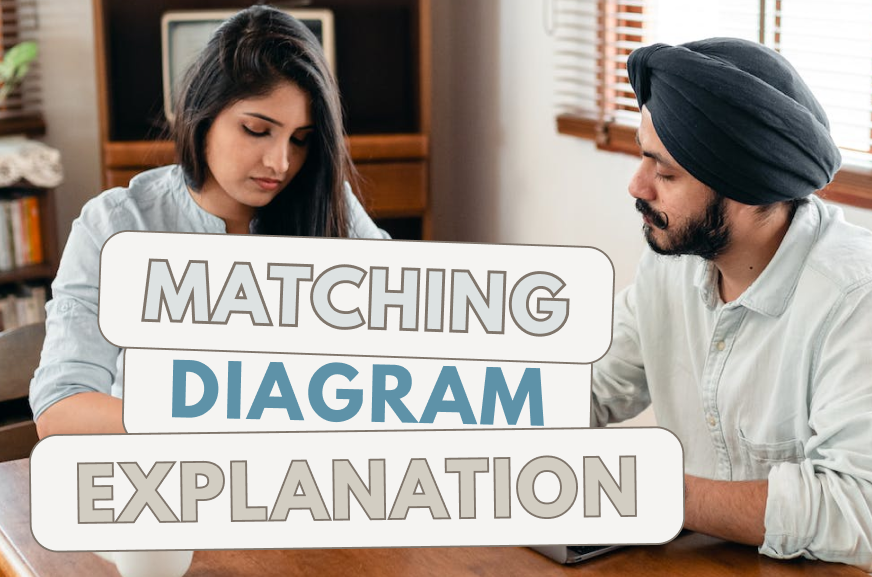I’ve received several requests for a diagram of my Grouping: Matching Logic Game, so here goes.
This article includes my version of the main diagram for this Logic Game. It also includes my diagram of the rules and some thoughts on making an effective diagram for this game (and games like it).
Here’s the main diagram:

Here are the rules that I would’ve put to the side because they can’t be placed easily on the main diagram:

Explanation of why and how I chose GHLRSV (the deities) as the base:
Many of you asked how I knew to put the deities as the “base”, rather than the students.
Because the rules tell us more about specific deities than about specific students.
Deities: GHKLRSV
Students: ABJP
Let’s look at the rules (which I’ve numbered below to reference easily):
1. Neither Lakshmi nor Rama answers Bobby’s prayers, but Ganesha and Krishna both answer Bobby’s.
2. Hanuman, Krishna, and Shiva answer Puja’s prayers.
3. Hanuman answers at least three students’ prayers, but Krishna and exactly one other deity each answer exactly two students’ prayers.
4. If Vishnu answers a particular student’s prayer, Hanuman does not answer that student’s prayer.
5. If Ganesha answers a particular student’s prayer, Rama does not answer that student’s prayer.
6. Lakshmi answers at least one of the same students’ prayers as Vishnu does.
7. Any deity who answers Puja’s prayers also answers Bobby’s but does not answer Arjun’s.
Rules 1 and 2 tell us equal amounts about deities and students.
Rules 3-7 tell us more about specific deities than about specific students.
For this reason, it’s much easier to use the deities as our base, rather than the students. As I mentioned in my hint in the game’s initial post, choosing the right base can allow you to make inferences more easily.
***
What makes this Logic Game hard?
Two things:
1. Its general ambiguity.
We don’t know exactly how many prayers each deity will answer, so this game is “loose.” In other words, there are many possibilities (in contrast to PrepTest 35, Game 2 – page 237 in Next 10 – in which 4/6 cars are fully determined).
(This is also unlike Grouping: Matching games such as PrepTest 37, Game 3 – page 306 – and PrepTest 38, Game 3 – page 332 – where the number of slots is explicitly given.)
In my Hindu deities game, only 3/7 deities “prayer-answerings” are fully determined: H, K, and V.
The other deities’ “prayer-answerings” are partially, but not fully, determined. I’ve used a dotted line (———-) to indicate ambiguity in the number of prayer-answerings.
Any letters below the dotted line are fixed. This means they will always be there in any valid scenario.
The letters above the dotted line might be there, but they also might not be there.
On the diagram, this means:
G might answer B only, but G could also answer the prayers of one or two other students as well.
L definitely answers A, but L might also answer J’s prayers as well.
R will answer at least A or J, but R might also answer the other one of those two as well. This is why I wrote A/J with the potential of the other (J/A) as well.
S definitely answers B and P, but there’s no reason S couldn’t also answer J.
2. The third rule
Particularly, this part of it:
“Krishna and exactly one other deity each answer exactly two students’ prayers.”
The entire game revolves around which “other deity” answers exactly two.
That “other deity” could be G, L, R, or S.
If G answers 2, then L answers 1, R answers 1, and S answers 3.
If L answers 2, G answers 1 or 3, R answers 1, and S answers 3.
If R answers 2, G answers 1, L answers 1, and S answers 3.
If S answers 2, G answers 1 or 3, L answers 1, and R answers 1.
***
Are all Grouping: Matching games like this?
No. You can breathe a sigh of relief. Some are much easier and can be solved by using templates / possibilities / limited options (whatever you call it, it’s the same thing).
PrepTest 37, Game 3, and PrepTest 38, Game 3 (both mentioned above) can be solved efficiently by using templates.

